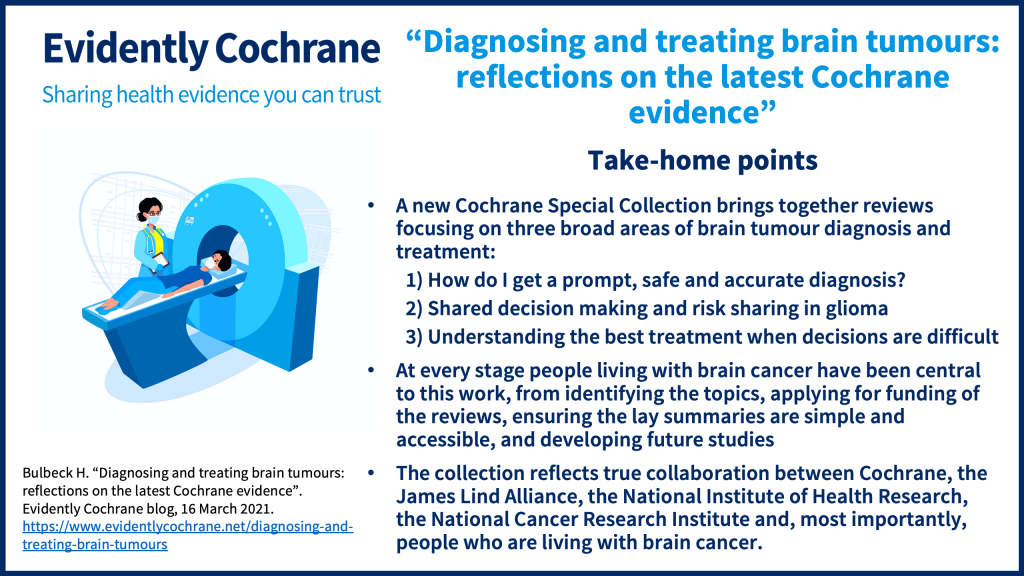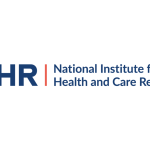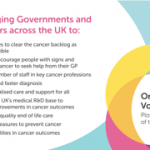Cochrane systematic reviews: bringing clinical research closer to people

The publication of the latest Cochrane Systematic Reviews on brain tumours brings together years of collaborative effort to transform the clinical research landscape and make it relevant for people living with a brain tumour.
So what are these reviews, why are they important and how do they fit into the bigger picture?
The brain tumour research agenda needs to be driven by the people with lived experience
Unlike lab-based research that focuses on the isolated cells and the distant hope for a cure, clinical research focuses on people, and improving their quality of life today.
Take Andrew:
Andrew is 42 years old, recently divorced, has three teenage children. He is living in rented accommodation which is unsuitable as a home for his children. He has been diagnosed with a glioblastoma, the most aggressive of brain tumours. With treatment he has a prognosis of about 9 to 15 months. He has lost his driving licence because of his diagnosis, and with this, his job as a carpenter. He is angry and isolated, feels guilty and fearful about what lies ahead. And yet every conversation he has with his clinical team is focused on treatment and his symptoms; he doesn’t know how to begin to talk about what really matters to him.
Decisions about research topics and funding have historically been driven by academia. But to improve outcomes for people like Andrew, people like Andrew need to be involved in identifying key topics for clinical research.
Transparency in the research selection process is vital to ensure there is no conflict of interest, or bias towards cell-based research, which can detract from the clinically relevant research that the brain tumour community needs.
Putting people with brain cancer at the heart of clinical research
That’s what the Neuro-oncology James Lind Alliance Priority Setting Partnership (JLA PSP) set out to do in 2015, when it published its top ten priorities. This list was determined by narrowing down upwards of 400 responses from the UK community when asked ‘What are the most important clinical questions?’.
In December 2017, the Cochrane Gynaecology Neuro-Oncology and Orphan Cancer Group (CGNOC), in collaboration with the National Cancer Research Institution (NCRI) Brain Tumour Group, received a grant to complete eight complex systematic reviews, categorised into three broad research areas:
- How do I get a prompt, safe and accurate diagnosis?
- Shared decision making and risk sharing in glioma
- Understanding the best treatment when decisions are difficult.
Who are Cochrane, and what are systematic reviews?
Cochrane is for anyone interested in using high-quality information to make health decisions. Whether you are a doctor or nurse, patient or carer, researcher or funder, Cochrane evidence provides a powerful tool to enhance your healthcare knowledge and decision making.
Cochrane’s members and supporters come from more than 130 countries, worldwide. Our volunteers and contributors are researchers, health professionals, patients, carers, and people passionate about improving health outcomes for everyone, everywhere. Our global independent network gathers and summarizes the best evidence from research to help you make informed choices about treatment and we have been doing this for 25 years. We do not accept commercial or conflicted funding. This is vital for us to generate authoritative and reliable information, working freely, unconstrained by commercial and financial interests.
Find out more about Cochrane here.
Systematic reviews identify and analyse all research published on a particular topic – providing reliable insight into the effectiveness of interventions, highlighting where knowledge is lacking and crucially, providing a guide for future research.
These Cochrane systematic reviews have already supported many recently funded, NCRI adopted studies. These include Future GB – a neurosurgical trial looking at different technologies and the Spring trial, which explores the use of prophylatic anti-epilepsy medication in patients who are having brain tumour surgery.
We’ve broken down the findings and what it means for people with a brain tumour – click here to read.
Collaboration is the key to change
At every stage of this process, people living with brain cancer have been in the DNA of this work: identifying the topics, applying for funding of the reviews, ensuring the lay summaries are simple and accessible, and developing future studies through the NCRI.
This transformation of the neuro-oncology clinical research landscape wouldn’t have happened without this genuine collaboration between patients, their caregivers and the clinicians who support the brain tumour community. brainstrust have been in the DNA of this work since the very first conversation about this happened in 2013. Our ability to be the mortar, reaching all stakeholder groups has been a key component of the success we’re celebrating today.
What’s next?
Well, we need to look at the remaining 15 uncertainties (11 – 25) to see what is still outstanding. And then we’re working on position statements based on these Systematic Reviews. And finally, the JLA PSP is like the Forth Road Bridge. We’re now 6 years since the top ten was published. Soon, we will need to look again at what matters most to people with a brain tumour.
Have any questions, or want to talk to us about clinical research? Email hello@brainstrust.org.uk









